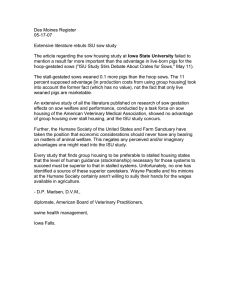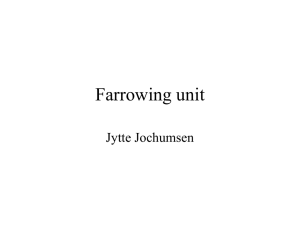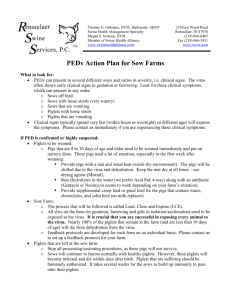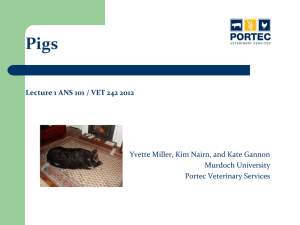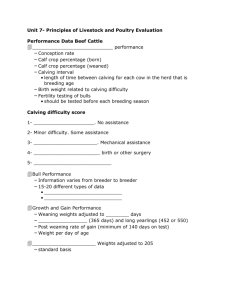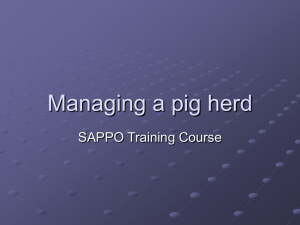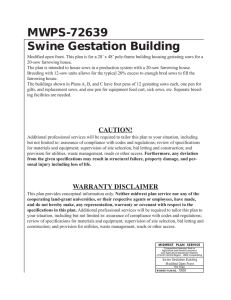Wayne F. Stansbury, John J. McGlone and Leland F. Tribble
advertisement
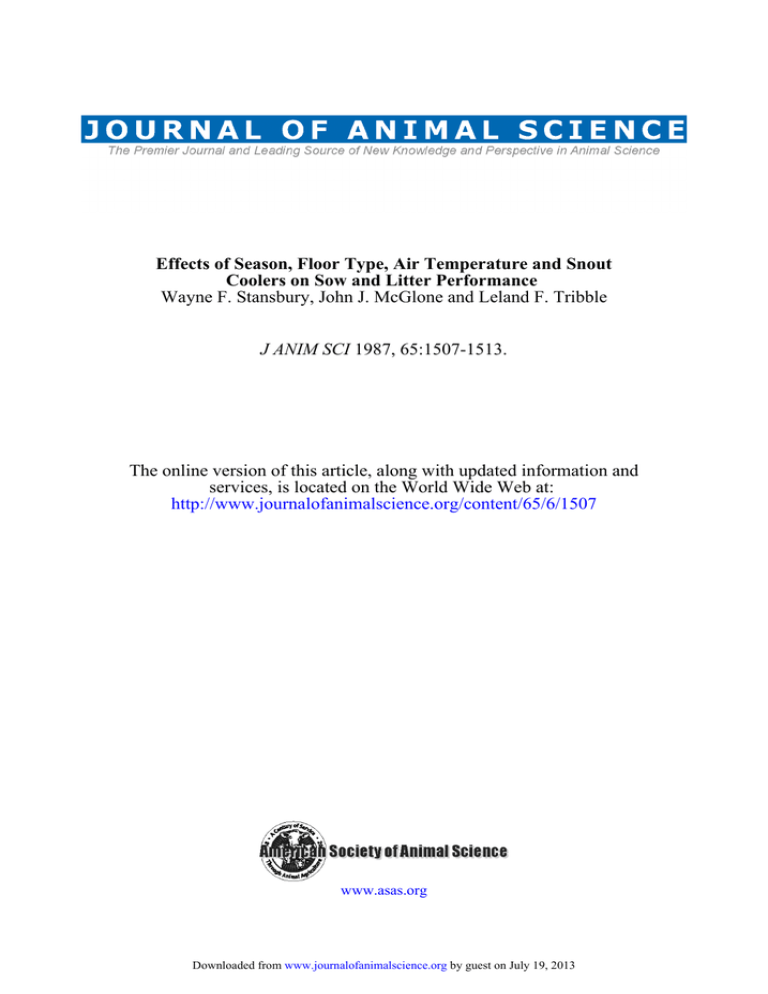
Effects of Season, Floor Type, Air Temperature and Snout Coolers on Sow and Litter Performance Wayne F. Stansbury, John J. McGlone and Leland F. Tribble J ANIM SCI 1987, 65:1507-1513. The online version of this article, along with updated information and services, is located on the World Wide Web at: http://www.journalofanimalscience.org/content/65/6/1507 www.asas.org Downloaded from www.journalofanimalscience.org by guest on July 19, 2013 EFFECTS OF SEASON, FLOOR TYPE, AIR TEMPERATURE AND SNOUT COOLERS ON SOW AND LITTER PERFORMANCE 1 W a y n e F. S t a n s b u r y , J o h n J. M c G l o n e a n d L e l a n d F. T r i b b l e T e x a s T e c h U n i v e r s i t y 2, L u b b o c k 7 9 4 0 9 ABSTRACT An evaluation of 341 sow and litter records over a 2-yr period was made to determine the effects of floor type and season on sow and litter productivity. Floor types were plastic-coated, expanded metal (PL) or concrete (CO) slatted flooring. Litters raised on PL had lower (P<.001) mortality (10.3 +- .85 vs 15.4 -+ .83%), fewer splay-legged pigs/litter (.20 -+ .06 vs .48 +- .06) and heavier weaning weights (61.0 t .8 vs 54.2 -+ .8 kg) than litters on CO. Sows ate less feed in the spring (P<.05) than during other times of the year. A second study was conducted with 88 litters to determine the effects of farrowing house temperature, floor type and snout coolers (SC) on sow and litter productivity. Farrowing house air temperature were 18, 25 or 30 C, with sows on PL or CO floors and with SC either on (910 cm/s) or off. At 18 and 25 C, average daily sow feed intake was higher (6.46 -+ .21, 6.13 +- .19 and 4.20 -+ .19 kg) and litter weaning weights were heavier (63 -+ 2.8, 61 -+ 2.5 and 52 -+ 2.5 kg) than at 30 C. Litter mortality at 18 and 30 C was higher (P<.05) than for litters raised at 25 C (20.4 +- 2.6, 18.8 +- 2.3 and 12.0 -+ 2.3%, respectively). Litters raised on PL at 18 C were 15 +- 3.4 kg heavier at weaning than litters raised on CO (P<.05). Providing SC increased sow feed intake at all air temperature (P<.05). However, SC sows held at 30 C ate less feed (P<.05) than sows held at 18 or 25 C. Snout coolers showed little benefit for litter performance while PL flooring, especially at 18 C, was beneficial to litter performance. (Key Words: Air Temperature, Floor Types, Sows, Pigs, Season.) I ntroduction S n o u t coolers (SC) a n d d i f f e r e n t f l o o r t y p e s h a v e b e e n u t i l i z e d b y p o r k p r o d u c e r s t o imp r o v e sow a n d piglet p e r f o r m a n c e a n d c o m f o r t in w a r m e n v i r o n m e n t s . S n o u t coolers decrease t h e negative i m p a c t o f h e a t stress o n sows in f a r r o w i n g crates b y increasing c o n v e c t i v e ( a n d p e r h a p s e v a p o r a t i v e - r e s p i r a t o r y t r a c t ) h e a t loss, w h i c h decreases surface a n d core t e m p e r a t u r e a n d r e s p i r a t i o n rate ( T a y l o r , 1 9 5 8 ; L i p p e r a n d M c G i n t y , 1 9 6 1 ) . C o n c r e t e (CO) f l o o r i n g m a y increase c o n d u c t i v e h e a t loss d u r i n g h e a t stress. P r e f e r e n c e studies b y F a r m e r a n d C h r i s t i s o n ( 1 9 8 2 ) i n d i c a t e d t h a t pigs p r e f e r p l a s t i c - c o a t e d , e x p a n d e d m e t a l f l o o r i n g (PL) over o t h e r p e r f o r a t e d f l o o r i n g . W e a n i n g weights ( W a s h a m , 1981 ; M a b r y e t at., 1 9 8 2 ) , survival r a t e s ( J e n s e n a n d Warren, 1981 ; Washam, 1981 ; M a b r y et al., 1 9 8 2 ) a n d k n e e a n d claw injuries ( W a s h a m , t The authors thank Mr. Stanley Harris and Mr. Benny Carrillo for technical help and Mr. John Drezek for typing the manuscript. College of Agr. Sci. paper no. T-5-228. Research supported by state of Texas line item for efficient production of pork. 2 Dept. Anim. Sci., Behav. Physiol. Lab. Received February 17, 1987. Accepted August 3, 1987. 1 9 8 1 ; M a b r y et al., 1 9 8 2 ; K o r n e g a y a n d L i n d e m a n n , 1 9 8 4 ) were i m p r o v e d w h e n litters were raised o n PL instead o f CO o r solid flooring. T h e o b j e c t i v e s o f t h e s e s t u d i e s were t o d e t e r m i n e t h e effects o f season, air t e m p e r a t u r e , SC, f l o o r t y p e a n d possible i n t e r a c t i o n s o n s o w a n d piglet p e r f o r m a n c e . Materials and Methods General. D u r i n g g e s t a t i o n a n d t h e w e a n i n g t o - e s t r u s interval, sows were f e d 2 kg o f a 13% c r u d e p r o t e i n s o r g h u m - s o y b e a n m e a l r a t i o n in m e a l f o r m each day. B e f o r e b r e e d i n g , sows a n d gilts were v a c c i n a t e d f o r leptospirosis. F o u r weeks b e f o r e f a r r o w i n g , b r e d sows a n d gilts were v a c c i n a t e d f o r erysipelas, a t r o p h i c r h i n i t i s a n d pasteurella. B e f o r e sows were d u e t o f a r r o w , a n d u n t i l w e a n i n g , sows were f e d a 14% c r u d e p r o t e i n s o r g h u m - s o y b e a n m e a l r a t i o n in m e a l f o r m a n d w a t e r ad l i b i t u m . W i t h i n 1 d a f t e r p a r t u r i t i o n , piglets' tail a n d t e e t h were clipped, ears were n o t c h e d , b o d y w e i g h t was r e c o r d e d a n d piglets received 1-ml ( 1 0 0 m g / m l ) intramuscular injections of iron dextran and a n t i b i o t i c . F o u r t e e n d a y s l a t e r b o a r s were c a s t r a t e d a n d creep f e e d was o f f e r e d . Sows in e a c h f a r r o w i n g g r o u p were w e a n e d a t a n average age o f 2 8 d in a n all-in/all-out m a n a g e - 1507 J. Anita. Sci. 1987. 6 5 : 1 5 0 7 - 1 5 1 3 Downloaded from www.journalofanimalscience.org by guest on July 19, 2013 1508 STANSBURY ET AL. ment scheme, with litters ranging from 21 to 35 d. Rooms were cleaned, disinfected and left vacant for a few days before pregnant sows entered. A four-breed rotational cross (Hampshire, Landrace, Yorkshire and Duroc) was used with crossbred sows and purebred boars. Farrowing and gestation facilities were totally enclosed and environmentally controlled. The farrowing houses were two separate rooms which accommodated 16 sows each. Farrowing crates measured 1.5 x 2.1 m with a 56-cm center area for each sow. Crates in each room had eighter CO or PL flooring. The dimensions of the slots in the CO flooring consisted of ten 1.3- • 46-cm openings at the front of the crate and six 1.3- x 76-cm and four 2.5 x 76-cm openings at the back of the crate. The four 2.5-cm openings were directly behind the sow. A steel grate was inserted between concrete slats before and up to 48 h after farrowing to prevent injury to baby pigs' feet. In the center of the CO crates were 90 cm of solid concrete. The PL flooring encompassed the total area of the farrowing crate and contained about 1,300 perforations/m 2 . All flooring was ground level (that is, not raised). Localized cooling devices (SC), connected to an evaporative cooling pad, were located at the front of each farrowing crate over the sow's head. Snout coolers could be independently turned on or off. Two gas heaters were located at opposite ends of each farrowing room and a 250-W heat lamp was located in the middle of the creep area in each farrowing crate. Fluorescent lights were on for 1 to 2 h/d in all buildings during feeding and animal care. Exp. 1. An evaluation of 341 farrowing records, collected over a 2-yr period (1983 to 1985), was conducted to determine the effects of flooring materials and season on sow and piglet productivity. Flooring materials in the farrowing barn consisted of either CO or PL flooring. Month was determined where the greatest a m o u n t of the lactation period occurred. The following months were combined to give four seasons for analysis: December, January and February = winter; March, April and May = spring; June, July and August = summer; September, October and November = fall. All litters were from crossbred sows. Of the 341 litters, 262 litters were from multiparous females and 79 litters were from primiparous females. Cross-fostering occurred when litter size was extremely large or when a sow died or was injured. Records included: average piglet and total litter weight at 1 d of age and at weaning, number of piglets born alive and dead, number of piglets at weaning, sire-breed of piglets, weight of sow when entering the farrowing house and at weaning, and sow feed intake. Mortality (%) was calculated for each litter as follows: [1 - (number pigs weaned/ number live pigs after transfer)] x 100. An arcsin square root transformation was used in the analysis of percentage data. Analysis of variance with a factorial arrangement of treatments was applied. The model included main effects of season and floor type, parity and the interactions among main effects. Number of live pigs nursing each sow at 1 d of age served as a covariate for all factors except number of piglets born. This factor equalizes effects of litter size and, to some degree, parity across treatments. Means were separated by t-tests, using error mean square as the source of variance (predicted difference procedure within SAS, 1982). Exp. 2--Ternperature X SC x Floor Type. Eighty-eight litters were utilized from January to March 1985 to determine the effect of farrowing house temperature, SC and floor type on sow productivity. Temperature and relative humidity were recorded by a calibrated 24 h/d hygrothermograph. Thermostats were set in the farrowing house for target temperature settings of 18, 25 or 30 C. The actual temperatures were 18.0 -+ .5, 24.7 -+ .2 and 29.9 -+ .3 C for the target temperatures of 18, 25 and 30 C, respectively. Relative humidity could not be recorded for the 25 C temperature setting. Relative humidity was 59.3 -+ 2.4% in the 18 C environment and 27 -+ 1.3% in the 30 C environment. Floor types were the same as described in the sow survey section. Snout coolers were set to direct air on the sow's head and neck at a velocity of 910 cm/s. Air temperature exiting snout coolers was not measured, but was always cooler than inside air temperature. Sows and gilts were randomly assigned to floor type or SC (on/off) treatments within each temperature setting. Measurements evaluated in this study were the same as in the sow survey except sow weight 24 h after farrowing and creep feed intake (CFI) also were recorded. Analysis of covariance for a nested design was applied to the data. The model was a complete randomized design with floor type and SC nested within the main effect of air temperature. Number of live pigs on each sow after cross-fostering on d I served as the covariate. Downloaded from www.journalofanimalscience.org by guest on July 19, 2013 FARROWING HOUSE ENVIRONMENT 1509 TABLE 1. LEAST-SQUARES MEANS FOR SOW AND PIGLET PERFORMANCE BY PARITY AND SLOTTED FLOOR TYPE (EXP. 1) Primiparous sows Multiparous sows P-values I tern Concrete floors Plastic floors Concrete floors Plastic floors Number of litters Litter weaning wt, kg Weaning number Pig weaning wt, kg Mortality, % Splay-legged/litter Sow feed intake, kg/d Sow wt loss, kg/lactation Weaning to estrus, d 52 50.28 8.4 5.99 b 14.39 .54 5.79 18.98 6.3 31 63.33 d 9.2 6.87 cd 6.29 .18 5.72 24.09 7.0 122 55.16 c 8.2 6.71 c 16.22 .48 6.63 17.46 5.2 136 60.78 d 1.16 8.8 .13 6.97 d .10 11.24 1.19 .22 .08 6.58 .12 22.35 1.54 4.8 .37 SE~ Floor type Parity Interaction .01 .01 .01 .01 .01 ,68 .01 .76 .44 .05 .01 .03 .89 .01 .41 .01 .01 .33 .02 .30 .61 .96 .95 .31 apooled standard error of the mean, n = 85. b'C'dMeans in the same row without a common superscript differ (P<.05). R esu Its Exp. 1--Survey, T r e a t m e n t m e a n s and standard errors f o r litter and sow weights and measures as a f f e c t e d b y f l o o r t y p e are p r e s e n t e d in t a b l e 1. Litters raised o n PL floors were larger ( P < . 0 2 ) and heavier at w e a n i n g t h a n litters raised o n CO f l o o r s ( P < . 0 0 1 ) . P e r c e n t m o r t a l i t y a n d n u m b e r o f splay-legged pigs/litter were higher in litters raised o n CO floors ( P < . 0 1 ) . F l o o r t y p e did n o t have a significant e f f e c t o n m o s t s o w measures. Sows lost m o r e w e i g h t o n PL t h a n CO floors ( P < . 0 1 ) . T w o variables were d i r e c t l y a f f e c t e d b y season, n u m b e r o f splay-legged pigs and daily s o w f e e d intake (table 2). Litters c o n t a i n e d f e w e r splay-legged pigs per litter during t h e s u m m e r ( P < . 0 5 ) t h a n during t h e fall or w i n t e r ; s p r i n g - t i m e i n c i d e n c e was i n t e r m e d i a t e . Daily s o w f e e d i n t a k e was l o w e r in t h e spring t h a n in a n y o t h e r season ( P < . 0 5 ) . A t r e n d was f o u n d f o r pigs to be heavier at w e a n i n g during t h e fall, s u m m e r and w i n t e r w h e n raised o n PL floors (P=.I ; figure 1). Exp. 2--Temperature x SC x Floor Type. T r e a t m e n t m e a n s and s t a n d a r d errors o f the m e a n s f o r litter a n d s o w m e a s u r e s are p r e s e n t e d TABLE 2. LEAST-SQUARES MEANS AND STANDARD ERRORS FOR SOW AND PIGLET PERFORMANCE BY SEASON (EXP. 1) Season Item Fall Spring Summer Winter SE~ P-value Number of litters Litter weaning wt, kg Weaning number Pig weaning wt, kg Mortality, % Splay-legged/litter Sow feed intake, kg/d Sow wt loss, kg/lactationb Weaning to estrus, d 75 56.67 8.6 6.64 13.22 .44 d 6.48 d 21.36 6.1 83 59.03 8.7 6.80 11.60 .32 cd 6.05 c 23.05 4.9 95 56.84 8.6 6.60 12.72 .17 c 6.56 d 19.98 5.6 88 58.18 8.5 6.92 13.94 .45 d 6.50 d 18.15 4.8 1.16 .13 .11 1.18 .08 .13 1.55 .44 .44 .48 .11 .83 .04 .02 .15 .13 apoo|ed standard error of the mean, n=85. bweight change from entering farrowing barn (pre-farrowing) to end of 28-d lactation. C'dMeans in the same row without a common superscript differ (P<.05). Downloaded from www.journalofanimalscience.org by guest on July 19, 2013 1510 STANSBURY ET AL. c bc ~:~ bc ad i- / / k\x.\'q 4. J ....... / / k\x.\'l /_,,% x,NN / Lx\x'~ / //IX\\'~ //'J~,'N //A~,.'N I 0 FAI,I. Figure 1. Interaction between season of the year and floor type on 28-d pig weaning weight. Means with different letters differ (P<.05; pooled SE=.15; n=341). in t a b l e 3. N e a r t h e s t a r t of this s t u d y , t h r e e sows o n PL f l o o r s w i t h n o cooling died b e f o r e or d u r i n g p a r t u r i t i o n . T h e r e f o r e , f a r r o w i n g r o o m t e m p e r a t u r e was l o w e r e d to 28 C u n t i l all sows h a d f a r r o w e d , t h e n t h e r m o s t a t s were a d j u s t e d t o 30 C. T o t a l l i t t e r w e a n i n g w e i g h t s were l i g h t e r in 30 C t h a n in 18 o r 25 C e n v i r o n m e n t s (P=.01). Average i n d i v i d u a l pig w e a n i n g w e i g h t was h i g h e r in t h e 18 C e n v i r o n m e n t ( P < . 0 0 1 ) t h a n in 25 o r 30 e n v i r o n m e n t s . L i t t e r m o r t a l i t y was 8 a n d 7% l o w e r ( P < . 0 5 ) in t h e 25 C t h a n in t h e 18 o r 30 C e n v i r o n m e n t s , respectively. Daily sow f e e d i n t a k e was similar in 18 a n d 35 C e n v i r o n m e n t s b u t was r e d u c e d in 30 C air t e m p e r a t u r e ( P < . 0 0 1 ) . S o w w e i g h t loss was g r e a t e r in t h e 30 C e n v i r o n m e n t ( P < . O 0 1 ) t h a n a t o t h e r air t e m p e r a t u r e s . S o w s in t h e 18 C e n v i r o n m e n t t o o k 2 to 3 d l o n g e r t o c o m e i n t o estrus a f t e r w e a n i n g t h a n sows in t h e w a r m e r environments (P<.01). T h e m a i n e f f e c t o f SC was significant f o r sow feed i n t a k e . Sows t h a t h a d access t o SC in t h e 30 C e n v i r o n m e n t c o n s u m e d 1.0 kg m o r e f e e d t h a n did sows w i t h o u t access to SC (figure 2). A l t h o u g h sow f e e d i n t a k e d u r i n g 30 C h e a t stress was i m p r o v e d b y SC, sow f e e d i n t a k e was still l o w e r t h a n in o t h e r air t e m p e r a t u r e treatm e n t s w i t h o u t SC. Piglet m o r t a l i t y was h i g h e r in t h e 30 C e n v i r o n m e n t w h e n SC were o n a n d in t h e 18 C e n v i r o n m e n t t h a n in t h e 25 C e n v i r o n m e n t w h e n t h e SC were o f f (figure 3; P=.05). Litters raised o n PL f l o o r s in t h e 18 C e n v i r o n m e n t were over 15 kg h e a v i e r at w e a n i n g t h a n litters raised e i t h e r o n CO at 18 C or t h a n litters o n b o t h f l o o r t y p e s in t h e 30 C e n v i r o n m e n t ( P < . 0 5 ; figure 4). Discussion B a x t e r a n d Mitchell ( 1 9 7 7 ) s t a t e d t h a t floors s h o u l d have c e r t a i n c h a r a c t e r i s t i c s : 1) n o t cause injury, 2) n o t c o n t r i b u t e t o i n f e c t i o n , 3) n o t c o n t r i b u t e t o stress, 4) b e m a i n t e n a n c e - f r e e , 5) b e easy t o clean a n d 6) have as r e a s o n a b l e cost. In t h e p r e s e n t s t u d y , o n l y p e r f o r m a n c e m e a s u r e s w e r e c o n s i d e r e d , b u t i n f e r e n c e s can b e d r a w n f r o m o t h e r studies t h a t h a v e c o n s i d e r e d t h e first t h r e e c h a r a c t e r i s t i c s o f f l o o r types. In this s t u d y , f l o o r t y p e i n f l u e n c e d p r i m a r i l y piglet m e a s u r e s . C o m p a r e d w i t h CO, PL r e s u l t e d in TABLE 3. LEAST-SQUARES MEANS AND STANDARD ERRORS FOR SOW AND PIGLET PERFORMANCE IN DIFFERENT FARROWING HOURSE TEMPERATURES (EXP. 2) Temperature, C Item 18 25 30 SE~ P-value Number of litters Litter weaning wt, kg Weaning number Pig weaning wt, kg Mortality, % Creep feed intake, kg/lactation Sow feed intake, kg/d Sow wt loss, kg/lactation b Weaning to estrus, d 29 63.23 c 8.1 7.82 c 20.35 c 3.13 6.46 c 3.14 c 7.3 c 29 61.13 c 8.9 6.g7 d 11.97 d 3.04 6.13 c 7.86 c 4.4 d 30 52.38 d 8.3 6.40 d 18.79 c 2.61 4.20 d 24.21 d 5.3 d 2.47 .27 .20 2.29 .74 .19 2.25 .62 .01 .13 .001 .04 .88 .001 .001 .01 apooled standard error of the mean, n = 29. bweight change from farrowing to end of 28-d lactation. c,d . Means m the same row with different superscripts differ (P<.O5). Downloaded from www.journalofanimalscience.org by guest on July 19, 2013 FARROWING HOUSE ENVIRONMENT ?" a a i i a r / A ~ " .\x~a ....... / / / lx~xx.N I //~\\\N o t| 2S I~ Figure 2. Interaction between environmental temperature and snout coolers on daily sow feed intake. Snout coolers had an air velocity of 910 cm/s. Means with different letters on bars differ (P<.05; pooled SE=.26 ; n=88). greater numbers and weights of piglets at weaning and fewer splay-legged piglets. An increase in weaning weights, pen cleanliness and increase in mortality has been associated with an increase in floor perforation (Washam, 1981 ; Mabry et al., 1982). Studies in which lesions on legs and feet of swine and preference of floor type by newborns have been observed may give some insight into differences observed in litter performance between the two floor types in this study. Jensen and Warren (1981) found that litters raised on PL floors had lower incidence of abrasions and lesions compared with concrete, metal and wood floors. Evidence of bleeding from knee abrasions were highest for 24 CO flooring. Farmer and Christison (1982) observed that piglets preferred to spend time on PL floors compared with perforated metal, fiberglass slats and woven wire floors. Baardson et al. (1980) reported that piglets raised on totally slatter CO floors had a higher incidence of nipple necrosis than piglets raised on PL floors. Although researchers have reported little relationship between foot and leg injury and performance (Jensen and Warren, 1981;Kornegay and Lindemann, 1984), data from Exp. 1 show that PL floors support greater litter weaning weights, reduced piglet mortality and fewer splay-legged piglets. Thus, the floor type that piglets preferred also supported greater litter productivity. In this study, a higher incidence of splaylegged pigs occurred on CO. Thurley et al. (1967) and Kohler et al. (1969) indicate that floor type and texture can influence incidence of splay-legged pigs. We observed that CO floors were wetter around the side and rear areas of sow. This observation may partly explain the higher incidence of mortality and splay-legged incidence on CO flooring. Because facilities were completely enclosed and extremes in outside temperature were tempered by use of SC during warm weather, season of the year had a relatively minor effect on sow and litter performance in Exp. 1. The summertime delay in return to estrus reported by Clark et al. (1986) was not found in this study. In Exp. 2, sows exposed to 30 C temperatures during lactation consumed less feed and lost more weight than sows exposed to continu- "l a 1511 b be 20" z/, //J iI' ab IS. 9 f//KN\"~ I / / ~,,,\~xn a a ///ab 14" i y/, 12' 10' / / 9, 4 Ax~x~a V/A~N---~ ///I~\\\N / / Ax\\\" q I" ltO i" 9/ .~\xx~ 4" 2" 0 II 26 I~ Figure 3. Interaction between air temperature and snout coolers on percent mortality. Means that do not have a common letter on bar differ (P<.05; pooled SE=3.19; n=88). 18 2I 10 Figure 4. Interaction between environmental temperature and floor type in farrowing crates on litter weaning weight. Means that do not have a common letter on bars differ (P<.05; pooled SE=3.44; n=88). Downloaded from www.journalofanimalscience.org by guest on July 19, 2013 1512 STANSBURY ET AL. ous temperatures of 18 and 25 C during lactation. Bond et al. (1952) reported that sows lost more weight as environmental temperature increased. Cox et al. (1964) indicated that a continuous temperature of 29 C had a greater detrimental effect on sow feed intake than fluctuating temperatures between 18 and 32 C. Studies in which sow feed intake was restricted during lactation (.45 kg/piglet or 2.32 kg plus .2 kg/piglet) showed that feed restriction increased sow weight loss with no effect on litter performance (Elsley et al., 1969; Hitchcock et al., 1971 ; Libal and Wahlstrom, 1975). Although sow feed intake in the 30 C environment was quite similar to the feed intakes of restrictedfed sows in other studies, litter weaning weights were adversely affected. Temperature may have had an indirect effect on piglet weaning weight, because the lower and higher critical temperatures for 5-kg piglets were thought to be 23 C and 31 C, respectively, on CO floors (Mount, 1968). Thus, piglets probably were not heatstressed in the 30 C temperature. Therefore, reduced piglet weaning weights at 30 C must be attributable to reduced sow feed intake and subsequent reduced sow milk production. Sows held at 30 C had reduced feed intake and increased weight loss during lactation. Mortality was lowest at the intermediate temperature. Litters raised in cooler environments (10 to 20 C) experience higher mortality due to chilling (Taylor et al., 1952; Parker et al., 1980; McGinnis et al., 1981 ; Nienaber et al., 1985). Although piglets are able to increase heat production by increasing their metabolic rate at an air temperature of 20 C, the pig's lack of insulation, sparse pelage and a large surface area-to-body weight ratio handicaps the pig in maintaining homeostasis (Mount, 1968; McGinnis et al., 1981). Therefore, we speculate that increased mortality at 18 C may have been due to chilling of piglets (sow feed intake was normal), but at 30 C increased mortality may have been due to reduced sow feed intake and reduced milk production. In the 30 C environments, SC increased daily sow feed intake but did not bring feed intake up to levels of sows in cooler temperatures (figure 2). Johnson and Taylor (1958) were among the first researchers to study the use of localized cooling devices for sows. Bond (1959) quoted Taylor (1958) as showing that cooling of the sow increased sow comfort and decreased rectal and surface temperatures and respiration rates. Also, Lipper and McGinty (1961) showed that in the temperature range from 26 to 33 C, cool air resulted in lower daily rectal temperatures and respiration rates for sows confined in crates but not for sows in pens. The tendency for litters raised at 25 and 30 C with SC on to have higher mortality that when the SC were off indicates that SC may increase piglet heat loss (figure 3). Piglets may not have been further chilled by SC at the cooler air temperature of 18C. Piglets raised on PL floors in the 18 C environment were heavier than piglets raised on CO floor in all three environments and on PL floors in the 30 C environment (figure 4). High piglet conductive and radiant heat losses on CO flooring may be responsible for the lower litter weaning weights on CO compared with PL floors at 18 C. However, thermal and physical properties of the floor seem less critical as air temperature increases (figure 4) to 30 C. However, the thermal property of the floor did apparently cause sow death on PL during heat stress. Overall, SC had little overall beneficial effect on litter performance. In cool and warm environments, PL flooring had a positive benefit on litter weaning weight. Sows and litters held at 30 C showed evidence of heat stress, which was not observed at 25 C. Heat stress depressed sow feed intake, piglets weaning weights and increased piglet mortality and sow weight loss. Piglet mortality was increased and the weaning-to-estrus period lengthened at 18 C compared with sows held at 25 C. The range of air temperatures supporting optimal sow and litter performance is apparently narrow, L i t e r a t u re Cited Baardson, B. A., J. A. Froseth and P. B. Anderson. 1980. Effect of floor type on the incidence of nipple necrosis in newborn pigs. Proc. West. Sect. Am. Soc. Anita. Sci. p 23. Baxter, S. H. and C. D. Mitchell. 1977. Development in floor construction in animal production. Vet. Ann. 17:286. Bond, T. E. 1959. Environmental studies with swine. Agric. Eng. 40:544. Bond, T. E., C. F. Kelly and H. Heitman, Jr. 1952. Heat and moisture loss from swine. Agric. Eng. 33:148. Clark, J. R., A. Kornkov and L. F. Tribble. 1986. Effects of parity, season, gonadotropin releasing hormone and altered suckling intensity on the interval to rebreeding in sows. Theriogenology 26:299. Cox, J. L., A. H. Jensen, D. E. Becker and B. G. Harmon. 1964. Productivity and behavioral responses of sows to thermal stress. J. Anita. Sci. 23:855 (Abstr.). Elsley, F.W.H., M. Bannerman, E.V.J., Bathruse, A. G. Downloaded from www.journalofanimalscience.org by guest on July 19, 2013 F A R R O W I N G HOUSE E N V I R O N M E N T Bracewall, J.M.M. C u n n i n g h a m , T.L. Dodsworth, P. A. Dodds, T. J. Forbes and R. Laird. 1969. The effect o f level of feed intake in pregnancy and in lactation u p o n the productivity of sows. Aim. Prod. 11:225. Farmer, C. and G. I. Christison. 1982. Selection of p e r f o r m a t e d floors by n e w b o r n and weanling pigs. Can. J. Anita. Sci. 6 2 : 1 2 2 9 . Hitchcock, J. P., G. W. Sherritt, J. L. Gobble and V. E. Haztett. 1971. Effect of lactation feeding level of the sow on performance and s u b s e q u e n t reproduction. J. Anita. Sci. 33:30. Jensen, A. H. and W. Warren. 1981. A comparison of flooring materials in farrowing crates. Univ. Illinois Swine Res. Rep. No. 1 9 8 1 - - 1 , Urbana, p I. Kohler, E. M., R. F. Cross and L. C. Ferguson. 1969. Experimental induction of spraddledqegs in newborn pigs. J. A m . Vet. Med. Assoc. 155:139. Kornegay, E. T. and M. D. Lindemann. 1984. F l o o r surfaces and flooring materials for pigs. Pigs New and Info. 5:351. Libal, G. W. and R. C. Wahlstrom. 1975. Effect of level of feeding during lactation on sow and pig performance. J. Anita. Sci. 4 1 : 1 5 4 2 . Lipper, R. I. and R. J. McGinty. 1961. Cooled breathing air for sows. Trans. Am. Soc. Agric. Eng. 4:8. Mabry, J. W., R. D. Jones and W. Seerley. 1982. Effects o f adaptation of a solid- floor farrowing facility utilizing farrowing crates. J. Anim. Sci. 1513 55:484. McGinnis, R. M., D. N. Marple, V. K. Ganjam, T. J. Prince and J. F. Pritchett. 1981. T h e effects of floor temperature, supplemental heat and drying at birth on neonatal swine. J. Anita. Sci. 53: 1424. Mount, L. E. 1968. The Climatic Physiology of the Pig. pp 60--96. Edward Arnold, London. Nienaber, J. A., M. D. Shanklin, G. L. N a h n and R. C. Manak. 1985. Performance of neonatal and newly-weaned pigs as affected by temperature and diet. Trans A m . Soc. Agric. Eng. 28:1626. Parker, R. O., P.E.V. Williams, F. X. Aherne and B. A. Young, 1980. Serum concentration changes in protein, glucose, urea, t h y r o x i n e and triiodothyronine and thermostability o f neonatal pigs farrowed at 25 and 10 C. Can. J. Anim. Sci. 60:503. SAS. 1982. SAS User's Guide: Statistics. Statistical Analysis System Inst., Inc., Cary, NC. Taylor, J. G. 1958. Individual air conditioning for farrowing sows. USDA Tech. Bull., ARS, 42:19. Taylor, J. G., M. T. Orem, L. P. Dyle and C. M. Vestol. 1952. F u n d a m e n t a l s of infrared brooding of pigs. Agric. Eng. 33:213. T h u d e y , D. C., F. R. Gilbert and J. T. Done. 1967. Congenital splay-leg of piglets: Myofibrillar hypoptasia. Vet. Rec. 80:302. Washarn, R. D. 1981. Wire-floored farrowing crates. Ohio Swine Res. Ind. Rep. No. 81--2. Ohio State Univ., Wooster. Downloaded from www.journalofanimalscience.org by guest on July 19, 2013 Citations This article has been cited by 1 HighWire-hosted articles: http://www.journalofanimalscience.org/content /65/6/1507#otherarticles Downloaded from www.journalofanimalscience.org by guest on July 19, 2013
